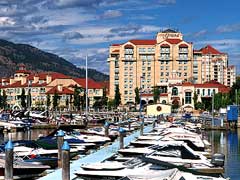That conclusion is one of a number that suggests the industry should be rescued and indicates the economic impact of boating in the Central Okanagan has the potential to grow to an estimated $68.7 million which is almost double of what it is today.
The RDCO commissioned the study in an effort to prepare a comprehensive plan for development of future recreational marine facilities on major lakes within the Central Okanagan which includes Okanagan Lake, Wood Lake and Kalamalka Lake.
I haven’t read the entire report, but it’s interesting that the summary doesn’t mention the fact that our waters don’t really flow according to political jurisdictions, and one could surly say the same of boating behavior. I would say that it’s safe to say - what one community does to it’s lake frontage, will impact other communities and their lake frontage.
My primary concern would be loss of habitat, pollution and emissions, which tend to ignore political boundaries as well.
The study should be applauded for its industry perspective that states, "The lack of a common vision for the future of boating in the Okanagan has resulted in an uncoordinated, inefficient and under funded system for the provision of recreational marine facilities in the Central Okanagan."
However, from a non-industry perspective the message gets failing grades as far as I’m concerned. It concludes that “there is a tremendous need for the provision of additional marine facilities in the Central Okanagan.”
"The current number and quality of recreational marine facilities is inadequate to meet the demands of residents and tourists. Local governments have made little investment in facilities," says the report, which adds that a number of marine improvements and additions are recommended, including:
- Five new boat launches, plus upgrades to most existing facilities
- Four new grey water pump-outs
- Six new "destination" docks
- Four dry dock storage locations.
The study indicates many of the facilities are urgently required within five years with the remainder with 10 years. The study also offered nine recommendations, including:
1. The RDCO take the lead role in establishing a coordinating body to collaboratively work with all local governments in the delivery of recreational marine facilities on the lakes.
2. The “Blueprint for the Future” be adopted by RDCO and the municipalities of Kelowna, Lake Country, Westside and Peachland as a guide for the development of recreational marine facilities on the major lakes.
3. All proposed marine facilities, be assessed for potential involvement by the private sector through joint ventures, contracting out, or private sector models.
4. Environmental considerations be taken into account for all developments as the environmental review identified that there are many sensitive foreshore areas as well as areas that are more suitable for marine facility development.
5. The development and improvement of boat launches and marinas with supporting infrastructure, and boat channels be given high priority by local government organizations.
6. The issue of provision and maintenance of mooring buoys be considered on a Region wide basis. A mooring buoy policy for the entire region should be developed, and then enforced in coordination with all local governments, the Regional District, BC Parks and Transport Canada. Long term moorage buoy use also needs to be considered.
7. New developments (residential and commercial) with waterfront access be reviewed for opportunities to provide additional facilities for public use, including transient and seasonal moorage, boat launches, gas pumps, pump-outs, public washrooms, and beach access. Official community plans should include provision of sites for marine recreational facilities.
8. The economic impact of boating be considered when reviewing waterfront plans and developments that include marinas and boat launches as well as those that provide destinations for local boaters and tourists.
9. Revenue generation be explored such as: launch and mooring buoy permits revenue from other levels of government including marine fuel taxes and boat registration fees using special area charges for marine facilities tourism grants and federal/provincial infrastructure funding programs.
This is exactly how “valley-wide” problems surface and why we eventually have tensions between communities. Primary oversights that do not consider impacts that go beyond political jurisdictions become expensive for all of us. RDCO says it will make the report available to Kelowna, Peachland, Westside and Lake Country for their consideration and response in light of possible financial implications, but there is no mention of sharing the document with regional districts in the North and South Okanagan or for that matter the public. Similarly the basic principle of perhaps doubling boat traffic in the big lakes should be seen as something like putting a highway though a neighborhood, where the initial concept should be open to public and environmental scrutiny far in advance of zoning a shopping mall at the end of the road.
It’s not like we haven’t made that mistake before.
Valley-wide, there are certain questions we should all be asking on this one, and it is my hope that during this civic vote, candidates will not only comment about unbridled growth and traffic on our roads, but now, on our lakes.
(30)
Don Elzer writes and comments about the future, current affairs, lifestyle and the natural world. He is a director of the Watershed Intelligence Network publishers of The Monster Guide, which can be found at www.themonsterguide.com
He can also be reached by email at: treks@uniserve.com


